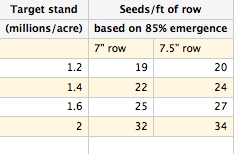Having lost many combining days because of wet weather, lots of wheat will end up being seeded late. Here are some tips to compensate for later planting.
Increase the seeding rate by 30 percent when later than the optimum seeding date. Planting rate during the optimum period is 1.2-1.5 M seeds/acre. If planting later, 1.6-2.0 M is the recommended range.
 As the number of days past the optimum date increase, so too should the seeding rate increase toward the higher end of the range. Higher seeding rates compensate for the reduction in tillering from seeding late.
As the number of days past the optimum date increase, so too should the seeding rate increase toward the higher end of the range. Higher seeding rates compensate for the reduction in tillering from seeding late.
Since seed varies in size, calculate the number of pounds per acre by dividing the target population by the number of seeds/lb and multiply by 1.15 to allow for germination and emergence loss.
Or, calibrate your drill by the number of seeds per foot of row as shown in the following table or use Table 1.7-3 in the Agronomy Guide (Page 83 in the 2011-12 hard copy edition)
Seeding no-till in corn stalk residue may require an additional 15% increase in seeding rate to compensate for loss under those conditions.
Maintaining proper seeding depth (1 to 1.5 inches) below the surface of the soil, not the residue, is critical to achieving good seed-to-soil contact and proper crown development. Shallow-planted wheat is more prone to winter injury.
Availability of potassium, and especially, phosphorus is very important. Phosphorus deficient plants do not tiller well and are more susceptible to winter kill. Here’s where good soil test records come in handy. If test levels are optimum or less, fertilize with recommended rates.
Normally a rate of 10- 30 lbs. of N/Ac. is recommended. Under late planting conditions, particularly in fields with little or no manure history, nitrogen rates at the higher end of the range help accelerate growth and stimulate tillering.






Post a comment
Report Abusive Comment